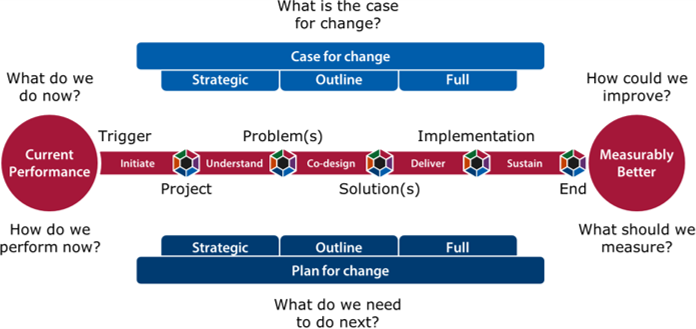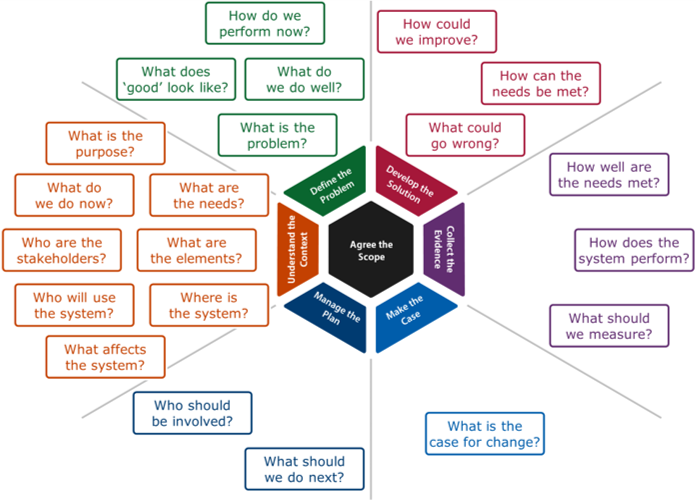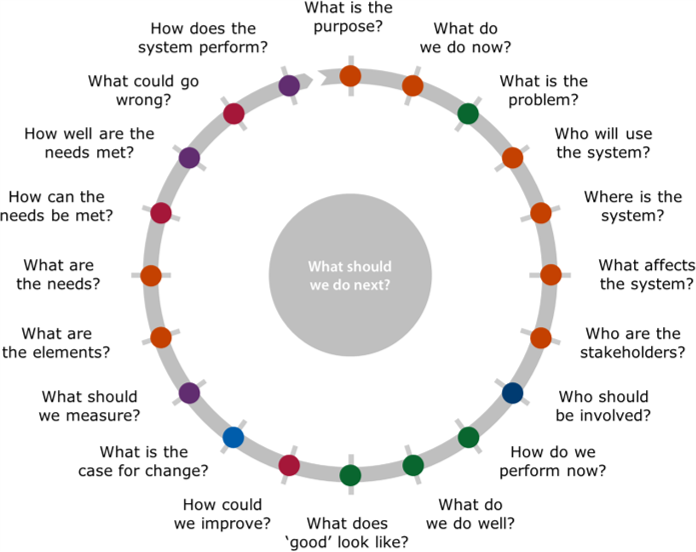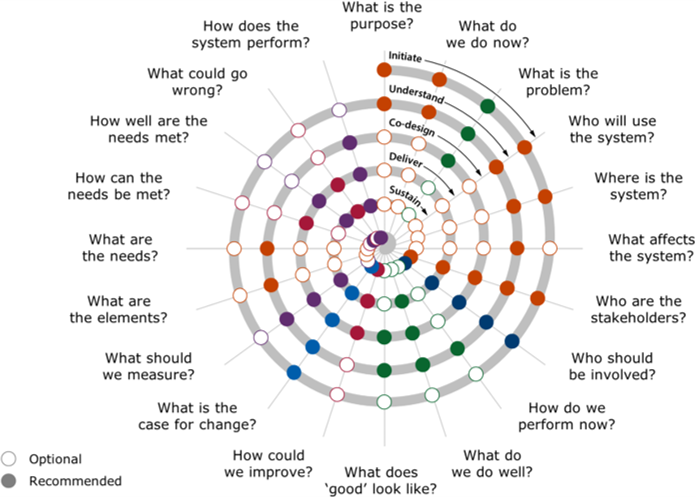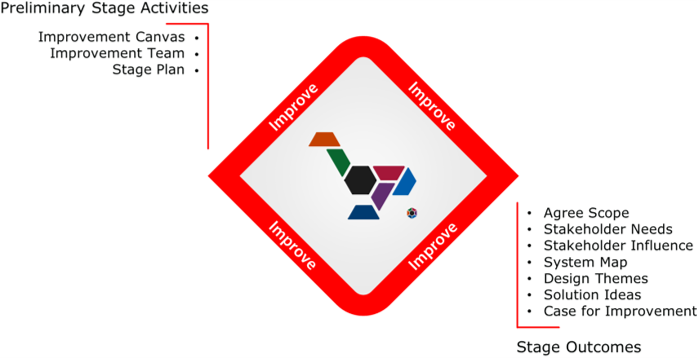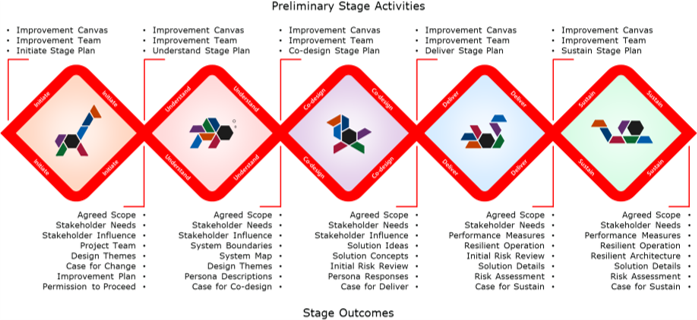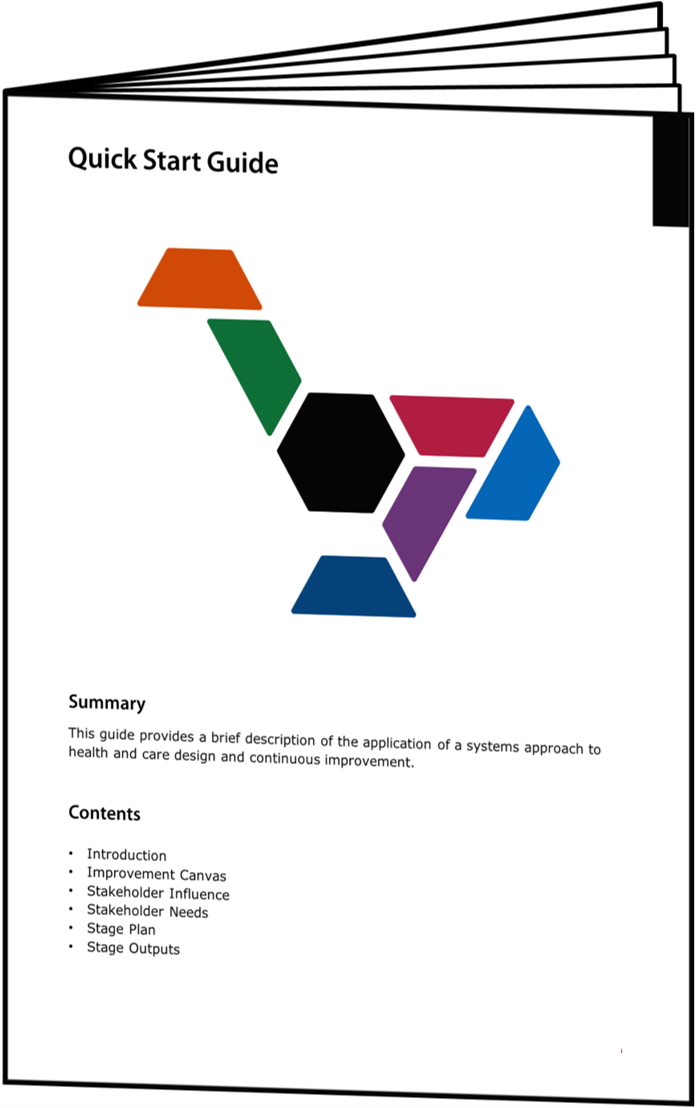The improvement programme is made up of a number of stages, each with their own targets and deliverables which can be based on the activity model. These should show progressive development of the targets as the programme progresses, with early focus more likely on context and problem and later emphasis on solution and evidence.
Typical stages of an improvement process are likely to include:
- Initiate — leading to an outline description of the current system (now), a preliminary understanding of the problem, a view of what the future system might look like (better) and a viable plan for initiating an improvement process.
- Understand — leading to a detailed description of the current system (now), a common understanding of the problem, a consensus view of what the future system might look like (better) and a clearly articulated case for changing the system.
- Co-design — leading to a clear description of the future system, based on the iterative design of the system architecture with its elements and interfaces, the evaluation through successive prototyping of its likely behaviour, and a plan for its delivery.
- Deliver — leading to the successful deployment of the new system with the levels of measurement necessary to evidence its success, and acceptance that it achieves appropriate value for its stakeholders.
- Sustain — leading to the continued operational success of the new system along with consideration of further improvement potential or wider deployment.
The addition of the Initiate Stage reflects the specific challenges associated with initiating a viable improvement project.
Useful toolkit resources: the Improvement Programme poster is included in the toolkit Resources.
The ‘gates’ between the stages are highlighted by the hexagonal improvement model, which characterises the key strands of an improvement process. The activity strands are broadly related to the questions of the systems approach and this link may be exploited when planning an improvement programme.
The majority of the questions relate to the Understand the Context and Define the Problem strands, which focus on the early stages of the improvement process. This is to be expected as the primary emphasis of the systems approach described in this toolkit is the problem-seeking part of an improvement process. The remaining questions then focus on the problem-solving and management parts of the process.
The activities required to answer these questions will likely take the form of a series of exercises, specifically aimed at building team ownership and commitment for a programme of improvement, targeted at the management team or a broader stakeholder team.
Useful toolkit resources: Questions Map poster and Improvement Questions cards are included in the toolkit Resources.
Improvement Questions
The cyclical model of the improvement questions reinforces the view that a systems approach is not a simple linear process, but an iterative process of continuous improvement. It suggests that the first question to be asked concerns the purpose to be addressed by the system. This would be followed by questions based on the perceived problem and about people to understand the background and context to the new system. The questions on systems, design and risk are then interwoven with the management questions to provide an opportunity to specify, design and evaluate the system and its constituent elements, with a question on what a good outcome would look like early in this sequence.
The idea would be that in the first pass of the cyclical model, preliminary answers would be provided to the questions. Further passes would offer an opportunity to provide more detailed answers or again to skip and use the previous answer for that iteration, with repeated reference to the question at the centre of the model.
In practice, iteration is likely to be present both within each stage of the improvement process and across stages. However, the latter is more likely to be reduced if there is some clarity in defining when the improvement process can proceed to the next stage. This approach to process management forms the basis of a stage-gate process where a spiral model of the questions, as introduced in Engineering Better Care, emphasises this view of progression. It also affords the opportunity to observe that some questions are likely to be more dominant than others at different stages of the improvement process, leading to the need for different activities and tools to answer these questions.
The cycles in this model reflect the initiate, understand, co-design, deliver and sustain stages of the improvement process. This process affords the opportunity to progressively increase knowledge of the problem, reduce uncertainty regarding the solution, and manage the implementation risk to an acceptable level.
Stage-gates
Stage-gates may be defined within the improvement process to provide targets and deliverables for attainment for each strand at each stage. Deliverables that assist in planning would be created in the early part of the stage, with the majority of deliverables planned for the end of the stage.
The questions to be answered within each stage of the programme would be chosen with early focus more likely on context and problem and later emphasis on solution and evidence. Likewise, the tools proposed shift in emphasis from problem understanding to solution delivery through the stages. The choice of questions and tools should also be consistent with the early and late deliverables envisaged for the stage.
The early formation of the improvement team and definition of a stage plan, consistent with the emerging contents of Improvement Canvas is essential to facilitate the timely creation of the end of stage deliverables. These then provide a target for the team and initial criteria by which the success of the stage may be measured. Progression from one stage to the next is then contingent on a reasoned review of the deliverables presented in the light of the overall ambition of the improvement programme.
Collectively, the stage-gates should reflect the aspirations for the whole improvement programme, the complexity of the challenge, and the number of gates (or intermediate gates) necessary to deliver measurable improvement. In practice, such definition is unlikely to be possible before the initiate stage has been completed and may be subject to variation as the improvement programme progresses.
A generic set of stage-gates can be defined for the initiate, understand, co-design, deliver and sustain stages, as a starting point for planning a particular improvement process. They follow the broad rationale of shifting the focus from problem seeking to problem solving as the process progresses. There may be many reasons to vary the detail and timing of these gates to suit specific needs, but they provide a starting point for such discussions.
The following sections provide more detail on each of the stages, highlighting the questions and tools of particular relevance to each stage. Quick start guides are available for each of the improvement stages in the resources section of the toolkit.
Improvement Planning
The delivery of each stage of the improvement process depends on the deployment of appropriate activities as part of a structured and coordinated plan to achieve the stage targets and deliverables. These activities may take the form of a series of questions or exercises, specifically aimed at developing a deeper understanding of the challenge, potential solutions and the means to deliver them into practice. They may be targeted initially at the management team or a broader stakeholder team, they may be addressed in sequence or out of sequence, and they may be formally presented or woven into the conversation with the team.
The activities are not designed to be rigid, rather they are intended to inspire enquiry across all areas of the improvement process in order to understand the context of the improvement challenge and the gap between the current performance of the system and its desired performance. Each activity may also be supported by one or more tools to provide structure and assist the delivery of useful outputs. The same tools may also be used for more than one activity.
The task of the facilitator or programme management team is to identify those activities which are essential to the improvement process, tailor the improvement programme to the particular improvement challenge and resource availability, and to configure and order them in such a way that they are most likely to deliver an effective improvement programme. It is also possible to combine activities and their associated tools with existing improvement approaches and models of change.
A summary of the improvement model and its role in driving improvement is given in a generic Quick Start Guide, designed to facilitate the early planning of an improvement process. This guide accentuates the role of stakeholder analysis, problem structuring using an improvement canvas, and planning in ensuring the right people are solving the right problem.
This guide provides an introduction to the improvement process and further detail can be found in the resources section of the toolkit and in the sections that follow.
Useful toolkit resources: printable PDFs for all of the Stage Guides are included in the Stage guide PDFs part of the Resources section.
Feedback
We would welcome your feedback on this page:
Privacy policy. If your feedback comments warrant follow-up communication, we will send you an email using the details you have provided. Feedback comments are anonymized and then stored on our file server
Read more about how we use your personal data. Any e-mails that are sent or received are stored on our mail server for up to 24 months.


